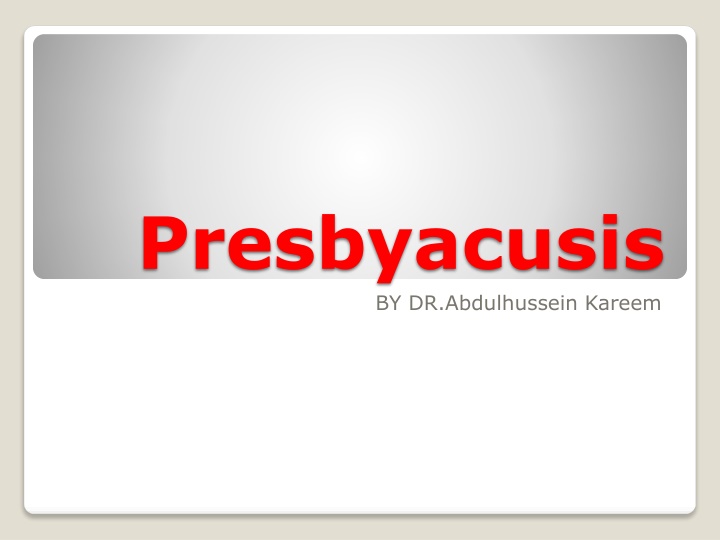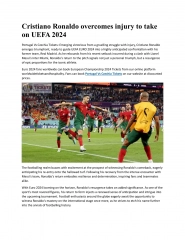Presbyacusis
Presbyacusis, or age-related hearing loss, involves the progressive degeneration of the auditory system with age, leading to hearing impairment. Both peripheral and central components are affected, causing a decline in hearing acuteness. The deterioration of sensory cells and neural pathways contributes to the development of Presbyacusis, impacting signal processing and frequency selectivity. Clinical features include moderate hearing impairment, difficulty in hearing high-pitched sounds, and challenges in understanding speech. Complications may arise in receiving and comprehending important information, affecting various aspects of daily life.
Download Presentation

Please find below an Image/Link to download the presentation.
The content on the website is provided AS IS for your information and personal use only. It may not be sold, licensed, or shared on other websites without obtaining consent from the author.If you encounter any issues during the download, it is possible that the publisher has removed the file from their server.
You are allowed to download the files provided on this website for personal or commercial use, subject to the condition that they are used lawfully. All files are the property of their respective owners.
The content on the website is provided AS IS for your information and personal use only. It may not be sold, licensed, or shared on other websites without obtaining consent from the author.
E N D
Presentation Transcript
Presbyacusis BY DR.Abdulhussein Kareem
As with all sensory systems in the human body, there is a progressive degeneration in the auditory system with ageing, which leads to hearing impairment in the affected individual. Presbyacusis is defined as the lessening of the acuteness of hearing that characterizes old age. Pathophysiology; Both the sensory peripheral(cochlea) and central(neural) components of the auditory systems
are affected and the deterioration appears to become more rapid with increasing age. Peripheral degeneration is responsible for two-thirds of the clinical features of Presbyacusis. Cellular degeneration leads to a reduction in the number of inner and outer hair cells ,particularly at the basal end of cochlea.
This can lead to secondary neural degeneration in the spiral ganglion. Circulatory changes such as arteriosclerosis, atrophy of the stria vascularis, and microangiopathy can lead to metabolic upset and further cell death. This leads to an elevation of hearing thresholds and a loss of frequency selectivity.
Degeneration in the central pathways leads to a reduction in performance of signal processing and this ultimately lead to combined sensorineural, rather than a sensory or neural impairment. No significant relation ship between Presbyacusis and B12 and Folate deficiency. Positive relationship between high cholesterol levels and hearing loss.
Clinical features; Moderate hearing impairment (45 dB hearing level averaged over .05,1,2,and 4kH) occurs in 4% of the age group 51-60 but in 18% of those aged 71-80. Men and women are both affected ,although the loss is more severe in men for the same age group. Rosen et al study in Sudanese tribe revealed significantly less hearing loss in elderly than those of urban society
Other people s speech sounds mumbled or slurred. Having trouble in hearing high-pitched sounds. Men s voices are easier to hear than women s. Some sound seem very loud and annoying.
Complications; Problems with receiving and understanding important information such as financial, health and legal information. Limit the person interaction with family and friends. Avoidance of important meetings. Safety risk and RTA.
Patients typically complain of difficulty in hearing which is worse in the presence of background noise, so that they find conversations difficult to follow. Localizing sound is difficult for the patient. Tinnitus in one or both ears. Many patient become socially isolated and even depressed.
Investigations; In the presence of an appropriate history and a symmetrical sensorineural hearing loss on PTA,little further investigations are required. The investigations are indicated in the following; Hearing loss in young patients. Asymmetry on a PTA. Unilateral tinnitus . Conductive component to the audiogram.
MRI is the investigation needed specially in cases of suspected vestibular schwannoma.
Management; As there is no curative treatment for presbyacusis ,the main aims in management. To assess the degree of disability . To provide hearing aid, Cochlear implant and middle ear implants. To rehabilitate the patient. Control the associated conditions.
Prevention; Keep the volume of ear buds and head sets at a safe level. Stay away from loud noises and reduce noise exposure. Stop smoking. Treat ear infections. Wear ear plugs























